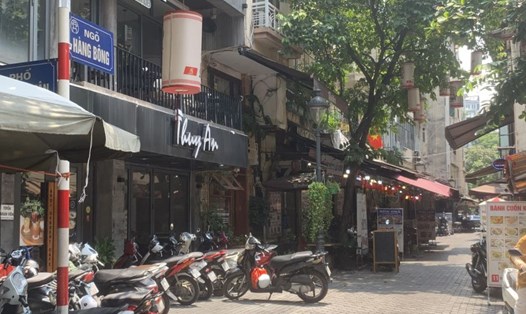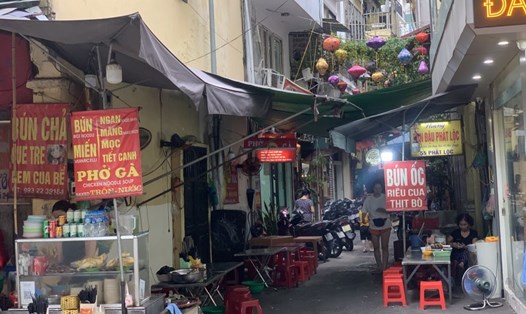DON'T GO LOOKING FOR CHICKEN SOUP
Next to the Cathedral area (Hang Trong ward, Hoan Kiem district) there is an attractive maze. Running along the left edge of the Cathedral is Au Trieu street (actually it should be called an alley), originating from Ly Quoc Su street to Phu Doan street, looking towards Viet Duc hospital.
Going about 100 meters into the street, just past the pho shop with cloudy water and the famous rare beef dish (raw beef is pounded with the side of a knife and then put into a bowl of pho and poured with broth) of Mr. Tu Lun's grandmother and granddaughter - a famous long-standing pho restaurant - you will see a small sign saying Tho Xuong Alley.
Tho Xuong Alley is very narrow, winding like a skeleton, intersecting with another slightly wider alley, before turning to Phu Doan Street. That alley is Huyen Alley, also starting from Ly Quoc Su Street connecting to Phu Doan Street. They form a maze, very easy to confuse for strangers.
It is not difficult to understand, because this whole area is Tho Xuong district (Hanoi) established around 1530, where Bao Thien ward is located (including the entire Bao Khanh, Nha Tho, Ly Quoc Su areas... now). Bao Thien ward is named after Bao Thien pagoda, built in 1057, during the reign of Ly Thanh Tong.
In this pagoda, there is a Bao Thien tower (literally Dai Thang Tu Thien Bao Thap) with a bronze top that emits a halo when it receives the morning sunlight. The top of the tower is considered the Four Great Treasures of An Nam, but was later destroyed by General Vuong Thong of the Ming invaders in the 15th century.
The reason for such a lengthy introduction is to introduce the profound history of Tho Xuong land in Hanoi's history since Ly Thai To chose this as the capital in 1010. The remaining traces are scattered in places such as: Bao Khanh, Ngo Huyen, Tho Xuong, Ly Trieu Quoc Su...
They have a close relationship with each other in terms of history and time. For example, Huyen alley is essentially the road leading to Tho Xuong district office. Now, Tho Xuong district no longer exists and the district office has long since disappeared, leaving only the vastness of “the old district school”.
It is also worth mentioning a strange confusion with Tho Xuong alley. There was a time, not long ago, when a teacher taught her students that Tho Xuong alley with its delicious stewed chicken soup was the place name that appeared in the folk song:
The wind carries the bamboo poles, the sound of the Tran Vu bell, the sound of the Tho Xuong chicken, the misty smoke spreads over thousands of mists, the rhythm of the Yen Thai pestle, the mirror of the West Lake...
But no, in the folk song, there is a Tho Xuong village located on the West Lake, with the sound of roosters crowing at night and the sound of pestles pounding paper in Yen Thai village and the early bell of Tran Vu pagoda. In Tho Xuong alley, there is no ginseng chicken soup, but in return, there are countless delicious dishes.
INTERSECTION OF DELICIOUS - NUTRITIOUS - CHEAP FOOD
Tho Xuong Alley is located next to a pho restaurant of the Tu Lun family, which was mentioned above. This restaurant is famous for being the favorite restaurant of a high-ranking leader, so it is crowded and the pho price is also quite high. If you want "delicious, nutritious, and cheap", turn into Tho Xuong Alley and find Oanh Pho Restaurant, which has been around for a couple of decades.
Pho Oanh is a typical alley pho, there is no storefront because the house is the place to open the shop, no signboard and no decent tables and chairs. The house in the alley is narrow, the alley is narrow so how can you put up a sign or arrange decent tables and chairs. Just use “aluminum plastic” items, which are flexible and easy to clean.
When the house is too crowded, they "move" out to the alley, and after rush hour, they "move" back into the house. This type of pho restaurant also creates a very "fidgety" behavior, ready to "move" both the person and the bowl of pho when faced with the situation of "let's move back, let me pass".
But Oanh's pho is also quite good, the quality is stable, pho connoisseurs praise the noodles and meat as good, but the broth is a bit weak. Her family has been selling pho for three generations, from the time her grandfather carried pho to sell all over the Phu Doan hospital area, then her father cooked pho during the cooperative period after 1975. As for the owner, it was not until the early 2000s that she took over her father's business.
However, Pho Oanh is most praised for its “stable prices”. Who would have thought that a bowl of pho located right next to Hoan Kiem Lake would cost only 30,000 VND, then 35,000 VND and now 40,000 VND. This price is 1/3 cheaper than other restaurants in the area - places that charge 60,000 VND for a bowl of well-cooked pho but still have a “natural Hanoian” look.
That’s why Pho Oanh is very crowded in the morning, waiting is common, if you’re fast you can cycle around Hoan Kiem Lake to get a seat, if you’re slow you can cycle around West Lake. That way of calculating time has become a “street legend”, like looking at the sunlight dividing the alley to see when it’s time to eat rib porridge.
In the past, at the intersection of Tho Xuong alley and Huyen alley, there was a rib porridge shop. That rib porridge shop only opened from 2 pm, when the alley illustrated the poem "The sun splits half the beach, it's afternoon", it was always crowded with customers eating the porridge that seemed to be only for "children" because it only had fine flour, mixed with a little bit of tender ribs, dried pork floss and crispy fried dough.
A bowl of Tho Xuong rib porridge costs only 10 - 15 thousand VND, but it is enough to warm the hearts of those wandering around the old town, or killing time all morning and noon in the surrounding cafes. They do not need lunch, but they need to eat a bowl of Tho Xuong rib porridge as an afternoon ritual, with the sacred bells ringing from the Great Church.
Tho Xuong rib porridge shop has long since disappeared, but it has managed to pass on its legacy to Huyen Alley. For about ten years now, Huyen Alley's rib porridge has been listed in the guidebook of afternoon dining destinations in the Old Quarter because it still retains the original culinary identity of this area: delicious, nutritious, and cheap.
A bowl of rib porridge with smoke, golden-yellow pork floss and fried dough sticks is still only 20 thousand dong. Eating rib porridge does not mean being full, but only a little time and space to sit and watch a Hanoi in the alley, also full of hustle and bustle, full of the people.
From rib porridge, clam porridge, duck eggs, fried eggs with perilla leaves, black bean sweet soup, fried banh chung, egg bread, iced sour plum juice, soy milk, fried sour spring rolls... A street-style snack food area was opened in the alley, or gathered in clusters, or scattered here and there at a corner in Huyen alley or Tho Xuong alley.
Nowadays, Tho Xuong alley and Huyen alley are no longer Hanoi alleys but have become more “globalized”. Foreign backpackers have also discovered the “delicious, nutritious, cheap” identity of this maze, so they have chosen this place to stay, eat and have fun.
Homestays and mini hotels are appearing more and more, along with tourism services, which have transformed this place. However, in the morning, bicycles still run into Tho Xuong alley to see if Pho Oanh is still available or if they have to “circle Hoan Kiem Lake”. In the afternoon, the warm smoke of ribs makes Huyen alley fragrant.









